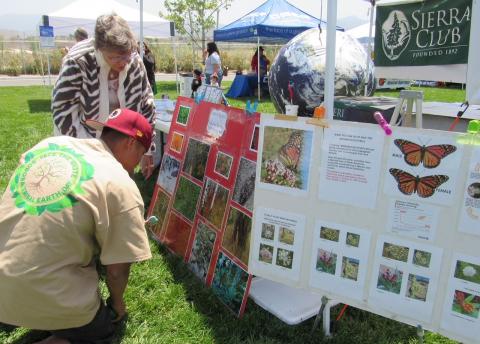Members of the Soboba Tribal Environmental Department organized Soboba’s 16th annual Earth Day celebration on April 28. More than 500 guests to the Soboba Sports Complex spent time visiting 40 vendors who provided conservation information and giveaways.
“We try to bring awareness about environmental issues that affect the whole world, such as climate change, and we have games and activities to spread important messages,” Environmental Director Christian Aceves said.
“Demonstrating that learning about the environment and adopting sustainable methods can be done in a fun and engaging way is our goal.”
Aceves said his favorite part is interacting with the “passionate local vendors and the amazing Tribal community members” in attendance.
An art contest of projects created by students at Noli Indian School on the Soboba Reservation utilizing recycled materials is an annual favorite. The first-place winner, Jay Dagostino’s 4th period biology class, will receive a pizza party for their environmental message touting flower and his second-place 5th period chemistry class is being treated to an ice cream party for their cockroach-themed project.
“For biology, this project fits with ecology, but for all classes it fits with community service and involvement which is also very important,” Dagostino said.
Another group of biology students who created a papier mache panda bear added a narrative to explain that “If we don’t protect the earth, the panda bear could go extinct. If we keep cutting down trees and ruin the forest environment, the pandas will not have food and will lose their habitat.”
Oceanography students made a statement using recycled materials to construct a sea turtle, adding written comments about its possible extinction. “If pollution in the ocean goes unchecked, trash like straws and plastic bags will continue to kill sea turtles at high rates. That’s why it is important to use metal straws and recycle plastic,” the note stated.
Soboba Cultural Department employees were on hand to pass out fresh produce cultivated from its Cultural Garden and to share information about the importance of white sage (Salvia apiana). This plant plays a significant role in Native American culture and is known for its practical and edible uses, as well as its medicinal properties. Visitors were given seeds to plant their own for personal use.
Soboba Tribal Administration, Soboba Casino Resort and the Soboba Foundation also had representatives on hand to share information and items with visitors. SCR set up a “pollination station” with pots, soil and seeds for take-home planting of bee-friendly flowers. Tribal Administration offered a choice of herbs in self-watering planters and the Foundation gave away plush beach towels.
“We want to encourage everyone to spend time outdoors with friends and family again, whether it’s here at our pool and splash pad or at a beach or lake,” Foundation Vice-President Catherine “Cat” Modesto said.
GRID Alternatives was one of the first booths guests could visit after checking in. Lisa Castilone, Community Development & Tribal Program for GRID Alternatives Inland Empire, explained the Soboba Fire Station Microgrid project being undertaken and answered all questions. When completed, a carport canopy will provide shade for team members’ cars while supporting the solar panels that will be connected to the grid.
The project will offer cost savings to the facility and backup power for emergency operations during power outages. This potential for long backup power will be especially effective during major emergency events, where the system can convert the Soboba Fire Station into a community emergency center. Castilone also had sign-ups for job-training opportunities for this and possible future projects.
Jana Desrocher and Patti Hudson from the US Forest Service, Idyllwild Ranger Station, explained how everyone can help keep forests and state parks healthy by following the “Leave No Trace” philosophy. They also were asking that everyone observe “Dim the Lights for Birds at Night” for World Migratory Bird Day on May 15 by dimming or turning off outdoor lights for one hour, starting at 8:30 p.m. to ensure that birds can navigate their routes without being affected by light pollution.
Soboba Tribal Preschool staff and teachers kept all children involved by helping them plant some seeds to take home to watch plants grow and also to paint clay necklaces they could wear. All the “tools” kids used were recycled from the school’s kitchen. Milk cartons, juice cups and water and juice bottles were modified to be used as planters and to scoop up soil.
A first-time vendor at Soboba’s Earth Day celebration was Inland Empire Waterkeeper, a nonprofit water quality advocacy organization dedicated to enhancing and protecting the quality of the waterways within the Upper Santa Ana River Watershed.
Also making a debut appearance were the Soboba Elders. President Glen Placencia and the group’s coordinator Erica Schenk helped guests pot some vegetable seeds to take home and grow. Schenk helped organize Soboba’s first Earth Day event in 2006.
“This year the Elders board wanted to do something out in the community,” she said.
Aceves said that aside from learning about good environmental practices he hopes the attendees gained a sense of community by sharing the event with one another.
“I hope they understood the Soboba Tribal Environmental Department is first and foremost here to serve the Soboba Tribal community to ensure their natural resources can be enjoyed for generations,” Aceves said. “Facing the truth regarding our impact to the environment can often be daunting. Although, it is important to face the truth and learn how we can all make small changes that together, as a community, can bring forth great change.”
Photos courtesy of the Soboba Band of Luiseño Indians










